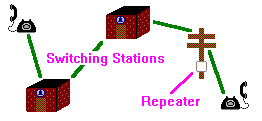
When terminals were first attached to mainframes, they could only be connected with cables that ran directly between the two devices. Eventually, a terminal was placed far enough from the processor, that the signal strength was too week to be recognized as data. This weakening of a signal is called attenuation, and is the result of the resistance of the wire. Today, communications technicians use the term media instead of wire, as it is possible that the device could be communicating over fiber optic cable. Believe it or not, fiber optic cable is subject to attenuation, just like wire.
The first method used to defeat attenuation was to amplify the signal. This amounted to cranking up the current (amperage) at the transmitter (the processor, in our example) to push through the length of wire. This presented a problem when the same port was used on a shorter length of wire, without adjusting the current. This resulted in the terminal receiving too much power, thus burning up its communications components.
What was needed was a device that could compensate for attenuation without throwing the signal out of specifications. Rather than amplify the signal at the processor and push the signal, another option is to install a repeater on the cable. A repeater, accepts the signal from the transmitter, amplifies the signal back up to specifications, and retransmits the signal to a the device. As the signal is never boosted above the maximum that the end device can accept, there is no risk of blowing-up the terminal.
| Consider the case of a telephone conversation. The signal is generated at the caller's phone, and sent across a wire to the telephone company's switching station. The switching equipment acts as a repeater by handing the call off to the telephone company switching station that services the called party. That station repeats the signal to the receiver's telephone. Depending upon the distance of each of the telephones from the switching stations, the phone company may have another repeater installed in the line. This is usually the case in rural areas. |

|
The telephone company is called telco, because you are often not sure what particular telephone company you will be dealing with. City dwellers may not realize that huge expanses of the American countryside are service by privately owned, independent, telephone companies.
A telco switching station is referred to as a central office, or CO, even though that station may not be the main switch. This term is left over from when each city had only one station and it was in the center of town.
| Consider an office campus where the processor is in one building and terminals are in a second building. In the data systems of forty years ago, it was not unusual to have repeaters installed in the basement of the second building. This worked, but did not allow for the situation of a building in another city. Each company could install their own cable and repeaters across the country, but the cost of such a system far outweighs the rewards. |
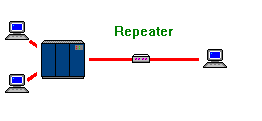
|
The solution to this problem was presented by Ma Bell. As a unified global voice carrier, servicing three-fourths of American telephones, AT&T's Bell System had all the wire, repeaters, and personnel necessary to maintain a connection between two cities. All they needed was a device that could connect, or interface, the data system to the telephone system. This device would have to take the data from the processor, convert it to an audio signal, and place the signal on a set of wires.
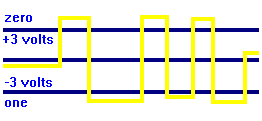
|
It was the interface that would prove to be the biggest problem.
In the master-slave relationship between a terminal and a
processor, the data is being conveyed by varying the voltage on
the cable. If the voltage is above a specific level, say +3v,
the terminal considered the data to be a 0. If the voltage was
below -3v, the terminal considered the data to be a 1. (Any
signal between these levels was not considered valid data.)
|
| On a telephone conversation, however, the voltage remains constant and it is the current that changes. If the caller is silent, no change in current is realized at the called party's set, so the receiver is silent. When the caller does speak, the receiver vibrates to recreate the same frequency. Unlike a digital transmission, these signals are not specifically limited to certain levels, however. |
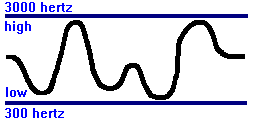
|
A signal that is allowed to change, or modulate, across a range of frequencies is called and analog signal. A signal that is limited to two states is called digital.
As the Bell System was designed to carry analog voice conversations, all the repeaters were analog repeaters. This meant that the device that interfaced the terminal to the phone line had to change the digital ones and zeros into an analog signal. It was decided that a digital one would be the same as a tone of 1,270Hz and a zero would be 1,070Hz. By modulating the signal between these two tones, a digital signal could be interfaced to an analog line.
| As the digital value of each of the tones is set the same in each of the devices, the receiving device could execute the analog to digital conversion. This reversing of the process is called demodulation. A device that takes a digital signal, converts it to analog for transmission, and converts a received analog signal to digital, is called a modem. It was given this name because it modulates and demodulates the signal. |
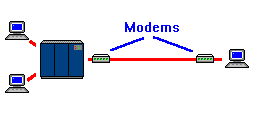
|
In recent years, the term modem has become universally accepted among laymen as the device in a data system that connects to the telephone system. A telecommunications professional can not make this mistake, as we will learn later in this article.
Let's backtrack to the discussion of terminals in other cities. We agreed that if Ford Motor Company wanted to connect its mainframe in Detroit to it's plant in Kansas City, the cost of maintaining its own poles, wires, and repeaters would have been unjustifiable. As Bell already had the wires in place, Ford could contract with Bell to provide a connection between the two cities. This connection is called a leased line as the wire is strictly for one customer's use, but is owned by Bell. The design of a leased line circuit differs from that of a dial telephone, because it bypasses the central office switching equipment.

| The majority of telecommunications links in a data system are leased line circuits. There are times, however, when a switched connection is preferred. The diagram of a master-slave terminal could distinguish between a leased line and switched connection by replacing the straight line between the devices with a lightning bolt to show a leased line, or a cloud to show a switched (dialed) line. |
As business systems grew, programs became more complex, and the volume of data flowing through the world's data systems increased, it became apparent to Bell that using a telephone system designed to handle voice conversations was not the most efficient method of transferring data. This was a market driven realization, because they were beginning to loose large customers to companies that offered digital to digital transmission via ground base microwave or satellite. It was not an issue of the digital to analog to digital conversion, per se, it was an issue of the analog repeaters (designed for voice) not being able to handle the transmission speeds customers wanted.
At this point, lets make one thing clear: voice and data are electrical signals, and all electricity is said to travel at the speed of light. This is important because when one refers to the speed of a data line, they are actually not saying anything. All lines are the same speed. What is different is the rate at which data can travel across the line.
Data rates are measured in bits per second, or bps. It is possible to establish a data call at 9600bps, but to place equipment on this line that can only communicate at 2400bps. The ceiling that a line can function at is called the bandwidth. In this case, the line would have a bandwidth of 9600bps and a data rate of 2400bps.
There is another term most people have heard, and some still use. The term baud is an antiquated term that deals with the Baudot Paper Tape system. Baud is a term that should be avoided, as 2400 is the maximum, actual, baud rate. There is no such thing as a 9600 baud modem, regardless of what the box says.
What was discovered, was that analog transmissions using voice repeaters were limited to 2400bps. It was possible to push the date rate to 4800, but only if the data system was programmed to check all data received for errors. An analog line could run faster if it was placed on a leased line circuit, and had high speed analog repeaters on it.
At this point some of you should be saying, "Wait a minute! I'm using a 28,800 modem attached to a switched analog line right now. What about that!" Reliable 2400bps switched modems were introduced for business use in the late seventies, the jump to reliable 9600bps did not happen until 1990. This was accomplished through a combination of software compression, frequency division, and phase key shifting. These are issues that will not be covered in this lesson. What is important to see is that it took well over a decade to make the jump from 2400 and 9600, but that it has taken only five years to move from 9600 to 56,000 on switched analog lines. By 1990, American businesses were regularly running data at over 1,544,000bps.
In order to allow customers to pass data at higher rates, digital repeaters were developed to replace their analog counterparts. For Bell, this created a second telephone system: one completely analog for voice and data, the other completely digital only for data. The digital network was found to be so superior to analog in its reliability, capacity, and signal clarity, that Bell soon began to move voice traffic from the analog to the digital network.
As the digital to analog conversion is not necessary on a digital line, there is no need for a modem. There is still a interface device between the terminal and the line, but it is known as a data service unit, or DSU.
When the DSU was first introduced, the Bell System was a homogeneous organization that did not allow customers to connect 'third party' equipment to their system. Rather than have their manufacturing division, Western Electric, construct a separate DSU for every possible data terminal a customer may want to hook up, Bell constructed a single line interface that all DSU's had to interface with. This device was called the channel service unit, or CSU.
| The CSU's job was to act as a customer premise repeater, a spike suppressor, and a test point on the line. It presented a common interface to which a DSU could be connected. It was the DSU's job to interface the CSU with the terminal. After the court ordered break-up of AT&T, the rules changed. It is not unusual to find a single device that contains both the channel service unit and the data service unit. This device is called a DSU/CSU. |
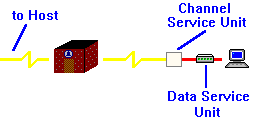
|
There is no standard method of graphically identifying whether a link is analog or digital. It is up to the chartist to label either the equipment or the link.
At the turn of the century we find that, even with the high availability of switched digital service, the majority of data links are still leased line circuits. There are still areas in the United States, serviced by small independent phone companies, that do not offer any digital service, switched or leased. As the majority of end user voice systems are still analog, many remote, single user terminals, are still connected via switched analog lines.
As far as we have come, our communications service can still only be analog or digital, and our only link options are switched or leased.

|

|

|